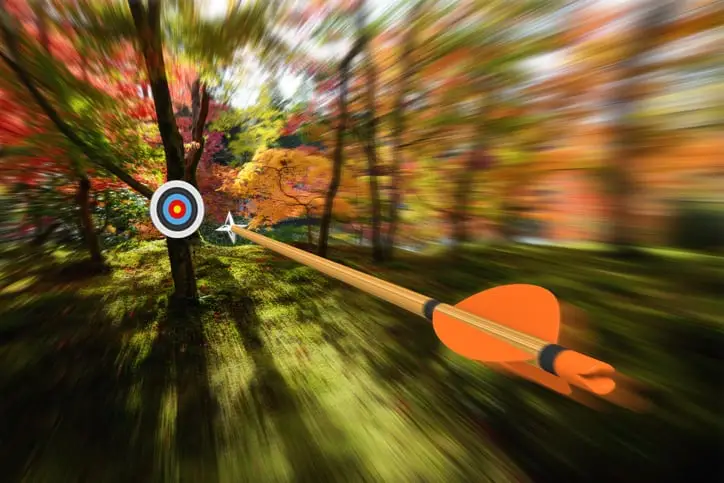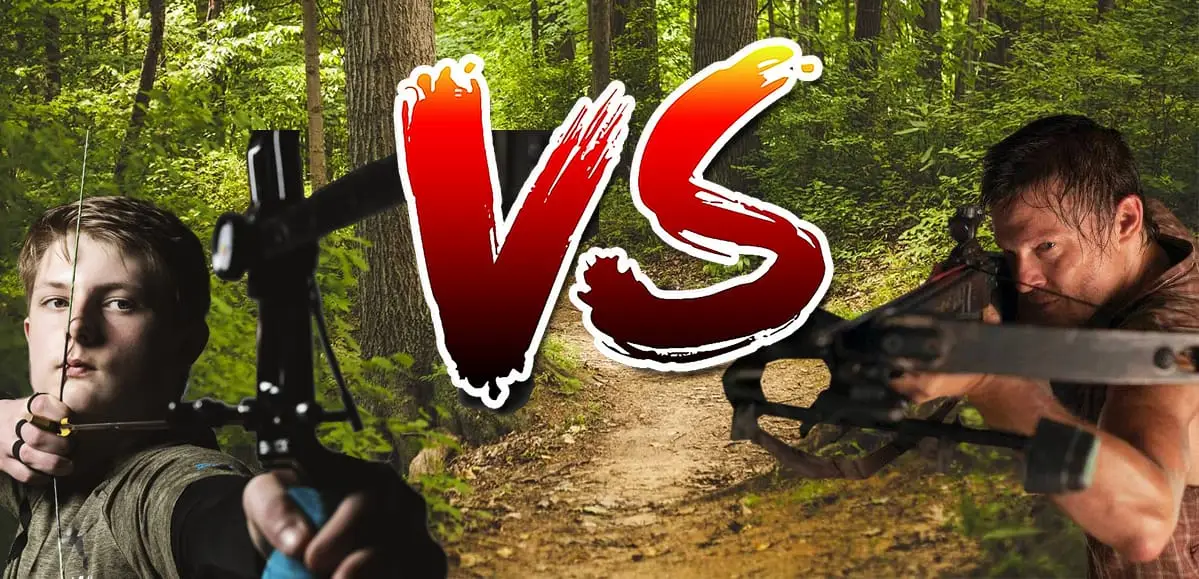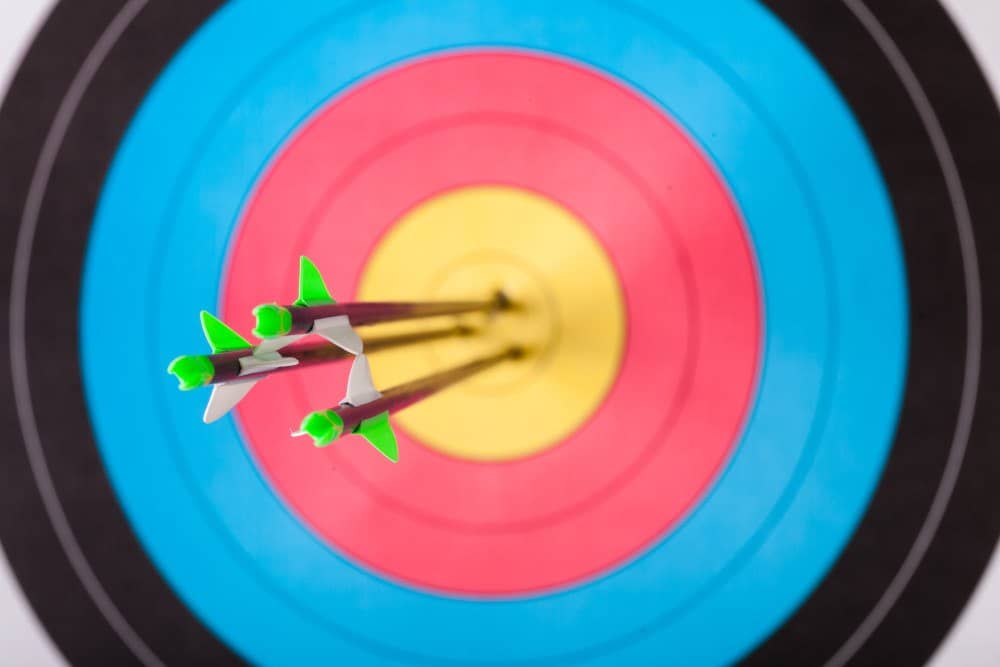Few things in the archery world are more frustrating than getting a new set of arrows just to immediately lose one in the fall foliage. Don’t snap your bow in half just yet! Follow these 10 tips for finding lost arrows, and you’re much more likely to get it back and avoid this frustration in the future.
Use a Lighted Nock
A lighted nock is a nock you can attach to the back of your arrow that emits a small but bright fluorescent light, usually colored highly visible pink or green. This helps to prevent lost arrows and find them for a number of reasons.
First of all, the lighted nock allows you to note the trajectory of the arrow as it leaves the bow, much like a tracer round from a gun. If you lose it, this gives you a better idea of the area to search.
More importantly, a lighted nock can prevent you from losing the arrow in the first place. An ordinary arrow may blend in with thick brush and foliage, but the lighted nock will stick out and be very easy to see. You can go right to your arrow and pick it up.
Retrace Your Shot
If you try to check the whole woods, or even just the area immediately surrounding you, you’ll never find an arrow. An arrow in the brush is as close to a needle in a haystack as you can get.
However, you can narrow down the area you have to search if you retrace your shot. This requires paying attention to the arrow’s trajectory as it leaves your bow, which is much easier if you had a lighted nock.
Another good way to narrow down your search area is to walk to your intended target—or the place where it used to be—and then turn to the direction your shot went off, right or left. You can look around a bit to the front of the target, but it will most likely be within 10 yards to the rear.
Take the Weather Into Account
The weather is one of the biggest factors when it comes to the trajectory of your arrow and its distance from a target, so it should be one of your top considerations when looking for a lost arrow.
The main thing to take into account is the wind. If it was blowing to the right of your target, that’s probably where you should look, and the stronger the wind, the farther from the target it might be.
Look for Broken Foliage
Once you have a general area to look in, you have to search for clues. Broken foliage is one of the best. The human eye is adept at picking up interruptions to patterns, so one trick is to pick a pattern in the woods and look for where the arrow might have broken it.
This pattern may differ depending on your local landscape, but it usually means fallen leaves, grass, or even mud. This break in the pattern will usually tell you where the arrow hit the ground, and it will be hidden nearby.
Use a Flashlight
But it’s not dark out, you say. A flashlight can help you find a lost arrow even during the day. Shine the light in the general area where you expect the arrow to be and look for glimmers and glints. The light from the flashlight easily reflects off the metal of the broadhead or field tip and, to a lesser extent, the arrow shaft, and this catches the eye.
In fact, you can make your arrows more reflective by installing arrow wraps on the shafts. Made of vinyl, these wraps also include graphic details that make the arrows easier to see when they’re hidden in brush and foliage.
Use a Rake
If you’re shooting in the woods, chances are your arrow is simply hidden out of sight, regardless of the lighted nock and arrow wrap you’ve installed. The brush and foliage can cover everything.
In this case, your best bet is to use a rake. Simply rake the general area where you expect the arrow to be and note whenever the rake catches on anything. You’re likely to find a few sticks before your arrow, but it will still speed things up considerably compared to your hands. And even if the rake itself doesn’t catch the arrow, it may turn up the foliage enough to expose it.
Use a Grid Search Method
If you haven’t been able to narrow down the location your arrow is likely to be, you can use a grid method to search a wider area. While you can do this mentally, it’s best to have a map of some sort. Divide the area into a grid of manageable sectors, just a few square yards, then search the sectors one at a time, marking them off once you’ve done so. This prevents you from skipping any areas and saves you from searching the same place repeatedly.
Train Your Dog to Help
Believe it or not, you can train Fido to help you find your lost arrows, though it admittedly takes some work—and a smart dog with an aptitude for tracking. The actual process is extensive and may take a few months, but the main idea is to familiarize the dog with arrows, their scent, and the associated commands. For example, start playing fetch with an arrow and call out “Find the arrow!” with each throw.
Once your dog understands the game, start hiding the arrow rather than just throwing it. Make sure you reward your dog every time it finds the arrow with lots of praise and the occasional treat. Next time you lose an arrow, tell Fido to go find it.
Use a Metal Detector
A metal detector is an extreme option, but it can be very effective if nothing else seems to be working. Metal detectors can pick up the metal broadhead or field tip, showing your right where the arrow is hidden. We recommend combining the metal detector with the grid search method to find your arrow as quickly as possible.
Keep an Arrow Loss Log
Okay, this may not help you if you’re looking for an arrow right now. But it’s a great strategy to prevent future losses.
Every time you lose an arrow, make a note in your log about the location and weather conditions. If you find it, make a note of where it was, why it was hidden (under leaves, buried in the mud, etc.), and how you found it.
By keeping an arrow loss log, you can gain insight and notice patterns with regards to your lost arrows. This can help you improve your technique and make finding lost arrows faster in the future.




